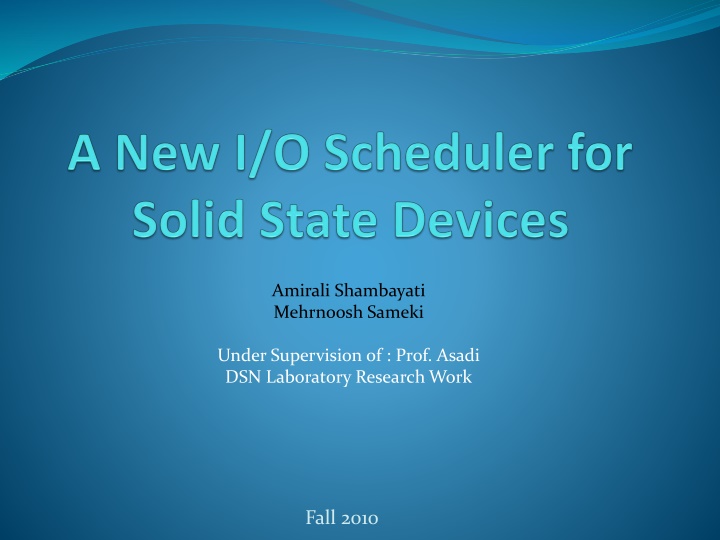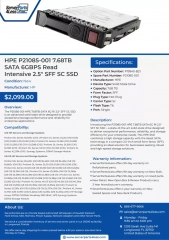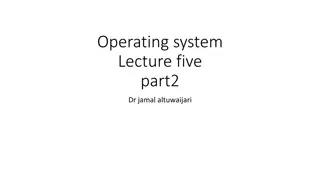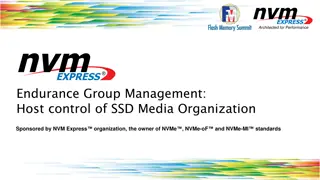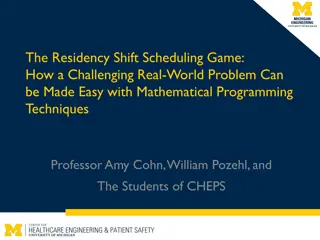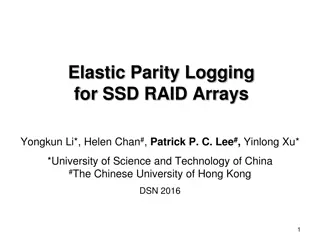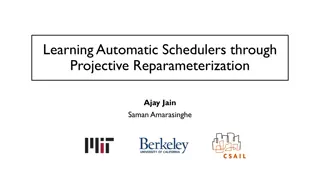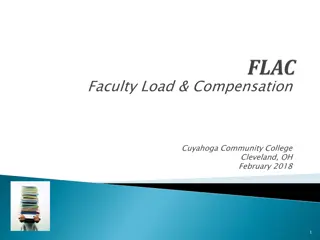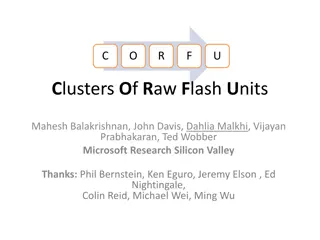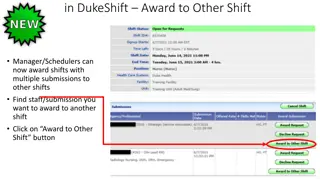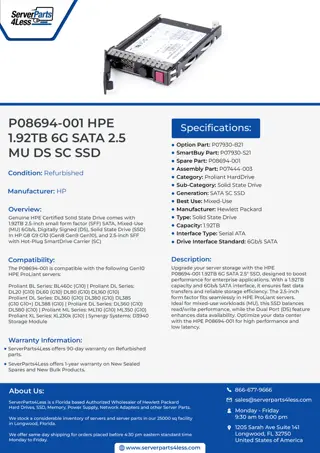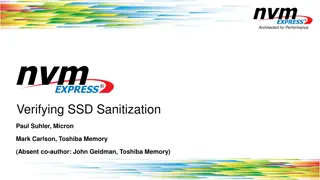Improving I/O Schedulers for Enhanced SSD Performance
Flash drives offer faster read speeds compared to traditional disks, but the performance can be affected by the Flash Translation Layer (FTL) and inefficient I/O schedulers. This research delves into proposing a new framework and design to optimize I/O subsystems for increased throughput and efficiency on SSDs.
Uploaded on Feb 17, 2025 | 0 Views
Download Presentation

Please find below an Image/Link to download the presentation.
The content on the website is provided AS IS for your information and personal use only. It may not be sold, licensed, or shared on other websites without obtaining consent from the author.If you encounter any issues during the download, it is possible that the publisher has removed the file from their server.
You are allowed to download the files provided on this website for personal or commercial use, subject to the condition that they are used lawfully. All files are the property of their respective owners.
The content on the website is provided AS IS for your information and personal use only. It may not be sold, licensed, or shared on other websites without obtaining consent from the author.
E N D
Presentation Transcript
Amirali Shambayati Mehrnoosh Sameki Under Supervision of : Prof. Asadi DSN Laboratory Research Work Fall 2010
INTRODUCTION Read speeds of flash drives are much faster than traditional disks Write speeds especially random write speeds, may not have such a clear advantage in performance
Flash Translation Layer(FTL) Flash drives also employ a Flash Translation Layer (FTL) which can have unforeseen effects on drive performance. Most SSDs employ copy-on-write mechanisms Remap blocks through the Flash Translation Layer (FTL). Different devices employ different policies at the FTL level for remapping blocks, garbage collection and erase operations.
Why to change current I/O schedulers? Current I/O schedulers take seek time, rotational latency overheads of magnetic disk drives into account in scheduling requests The current schedulers may not adequately schedule requests for SSDs.
What they have done? Proposing a framework for extracting important device parameters which will allow to redesign parts of the I/O subsystem to enhance performance. Proposing a new I/O scheduler design which will order writes more efficiently on the flash drive and result in increased throughput for many workloads.
I/O Schedulers Developed for HDD In traditional hard drives, writing or reading from nearby physical sectors is far less expensive than reading from distant sectors due to the expensive seek operations involved.
I/O Schedulers Developed for HDD So, I/O schedulers strive to reduce seek time and handles reads and writes to minimize head distance travelled. more advanced I/O schedulers functionalities are starvation prevention, request merging, and inter- process fairness.
Current Linux I/O schedulers Noop Scheduler Deadline scheduler Anticipatory Scheduler Completely Fair Queueing
Scheduler Comparison Postmark Benchmark has been used. Read and write operations were equally weighted.
FLASH DRIVE CHARACTERISTICS The three drives we studied are: Transcend TS16GSSD25- S 16GB drive, Memoright GT 32GB drive and the Samsung MCBQE32G8MPP 32GB drive.
Figure 3 shows a surface curve of the sequential read performance of the flash drive. Read performance appears to be unaffected by file size. but appears to degrade slightly as more data is requested to be read.
performance appears to be nearly the same. No surprise: no moving parts .so there should be no seek time, and thus, no difference between sequential and random operations.
The precipitous drop that occurs once the file size exceeds 512MB. The drive s performance becomes the major bottleneck. We just notice after 512 MB.
In Figure 6, we see that once the RAM caching effect has been nullified, the drive performs its writes in the 30MB/s range across all record sizes.
Random writes experience a severe drop in performance as the record size gets smaller.
Flash-specific performance tests To determine the size of the flash a series of stride writing tests has been developed. The strided write tests are structured so that the process will write a small amount of data (4k in our case), seek forward a fixed amount, write another small amount of data, seek forward a fixed amount, write again, and so forth.
If the latency peaks occur at fixed intervals independently of the amount of data written, we can assume that there is some boundary mechanism that triggers when a specific offset is crossed. If for varying strides, the latency peaks occur only after a set amount of data has been written, we can conclude that it is a buffering or caching bottleneck.
the latency peaks occur regularly every 1024KB offset, or after 128KB of data has been written in total. Either there is a characteristic of the drive that causes a peak after each 1MB page has been written or there is a 128KB buffer at some point in the pipeline that is being filled and must be flushed periodically.
The latency peaks still occur regularly at 1MB intervals. Compared to the 32KB stride test, we have only written half of the total amount of data as before when the latency peaks occur. we can say that the peaks do not occur due to the total amount of data written, but rather they occur when we cross into another 1MB block.
NEW SCHEDULER DESIGN a significant penalty is imposed when new blocks in flash are written to. Minimize the number of times that the penalty for new block writing is imposed design a scheduler which will always service requests that are in the same block as the previous request. We called it block preferential our block-preferential scheduler has no directional seeking preference, like traditional schedulers do.
Terminology Request x is in front of request y, we mean that the starting sector of request x is larger than the ending sector of request y. Request x to be behind request y, the starting sector number of request y must be greater than the ending request number of request x.
How to Modify Previous Schedulers? First: Request in front of the previously served request and request behind, lie in the same block as the most recent request, the scheduler will service the largest of the two requests first.
Second: One request which lies in the same block as the most recent request and one which lies in a different page. The scheduler will always service requests in the same block as the request which was most recently serviced.
Third: When both the front request and the back request are in different blocks If the two requests in front of the recently served request are in the same block, the scheduler will service the front requests, since they are in the same block and we can avoid an extra boundary crossing.
Fourth: Groups of front and back requests are in contiguous respective blocks, the scheduler simply chooses the largest combination of the two requests to service.
Results The figure in next slide shows Iozone sequential write performance results on different schedulers including new developed schedulers. The modifications to the schedulers exhibit a small 2- 5% improvement, over their unmodified performance with their new scheduler counterparts
Mixed workload To evaluate the scheduler under a mixed workload environment, they ran an Iozone mixed workload test. This test involved a combination of reads and sequential writes to be performed. For this specific test, the reads occurred twice as often as the writes. The results from this test are shown in next slide.
For the mixed workload, we can see that all of the schedulers which actively address the deceptive idleness problem perform much better, as we would expect them too. The modifications to the CFQ scheduler provide a small gain in this scenario, however, the modifications to the anticipatory scheduler provide up to 15% improvement in the mixed workload scenario.
the Postmark benchmark performs approximately 25% better with a modified anticipatory scheduler and approximately 18% better with a modified CFQ scheduler, when compared to their respective base schedulers. Neither of the new schedulers achieve the same performance as the noop scheduler
Previous figure shows that although new schedulers shows significantly better results than Anticipatory , CFQ and Deadline , but Noop still has the best results for this workload.
OLTP Benchmark The Sysbench OLTP benchmark was created to test system performance on a real database workload . A Mysql database is created on the disk to be tested and a series of complex transactional requests is performed on it. The results of this benchmark on the different drives are shown in next slides.
NILFS performance A very common solution to the random write problem on solid state devices is the implementation of a log-structured file system. To show that our scheduler is not negatively impacted by the presence of a logstructured file system, we present Dbench bencmark results with the NILFS2 file system in next slide.
